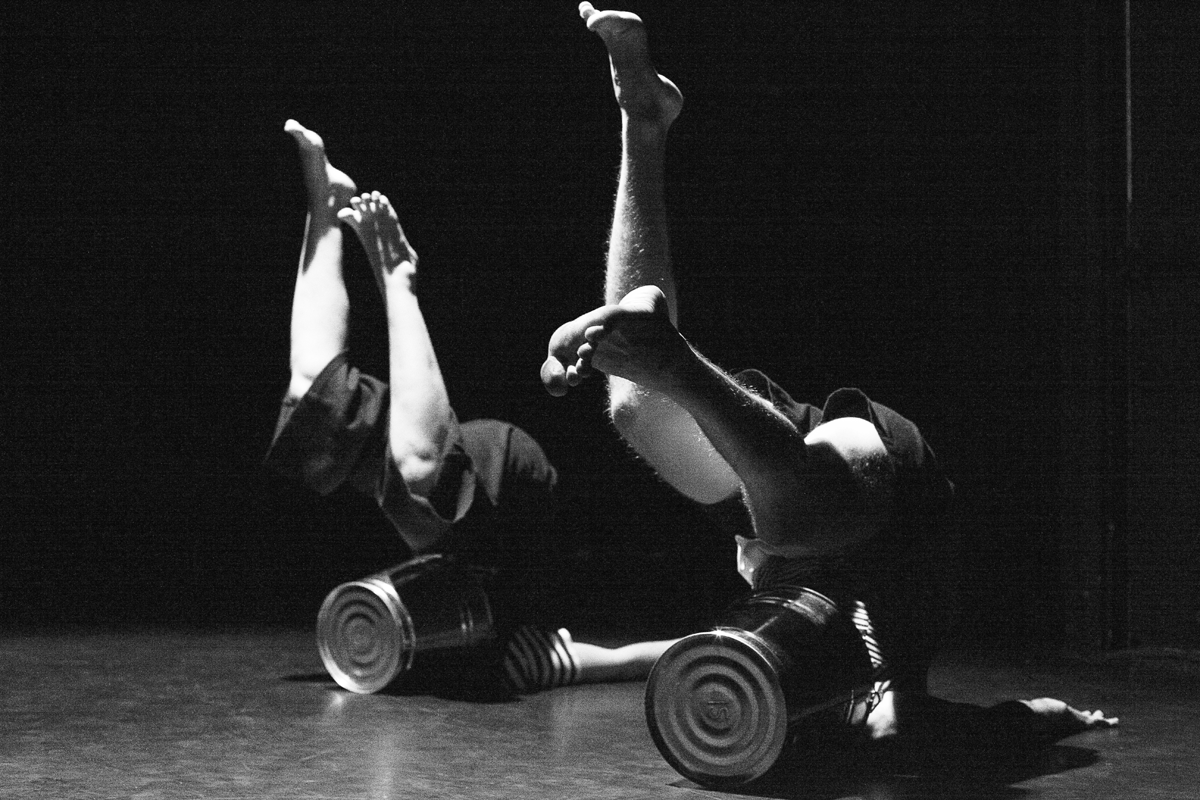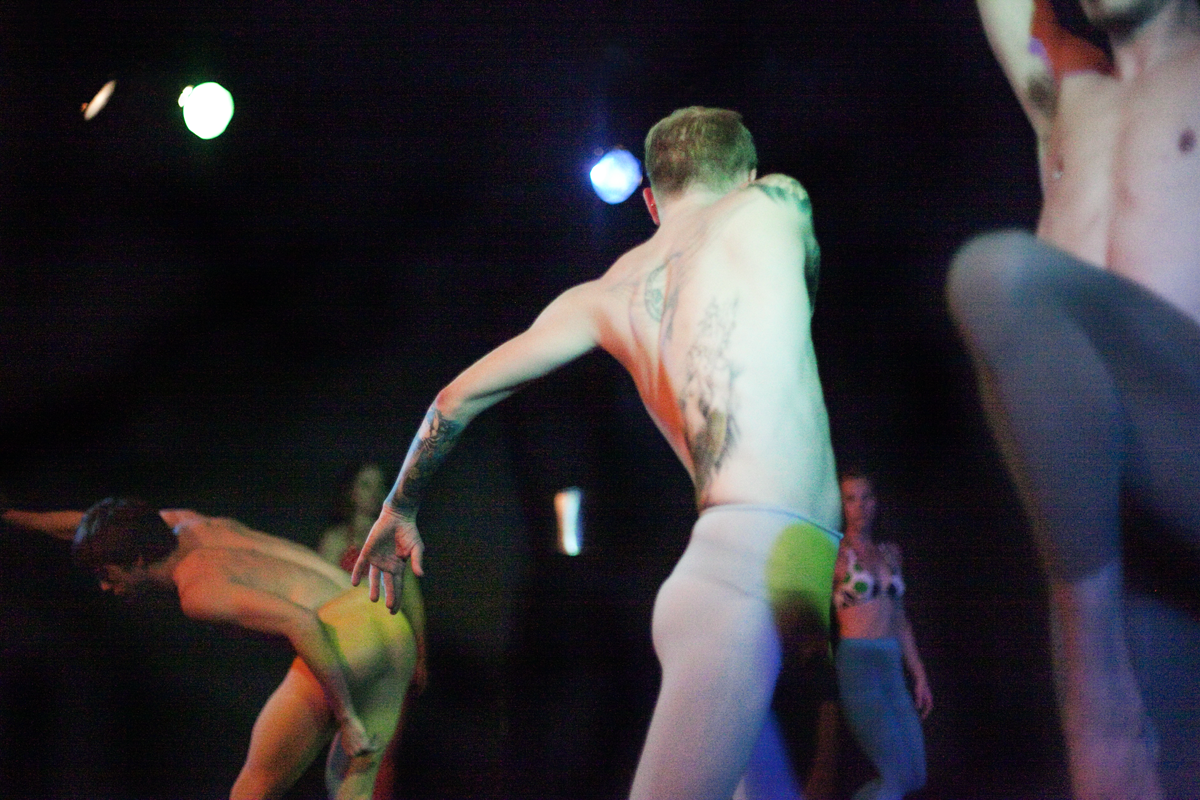Dancing in the Margins of Gender
Lightsey Darst had mixed feelings about "Tidal Tendencies," new dance works by local choreographers Jessica Briggs and Nick LeMere. She found herself wanting more, asking "What can a single evening of dance do against something so ingrained as gender?"



NICK LEMERE AND JESSICA BRIGGS WANT TO MESS WITH GENDER: this is the expressed intention of their Tidal Tendencies, an evening consisting of one piece by each, both performed by the same cast of six. LeMere and Briggs envision gender as a sensual and parodic playground in which no one is clearly anything and everyone is potentially everything. Thus we get equally slinky mermaids and mermen undulating around stage in latex-ish tails as shiny and sparkle-flecked as speedboats (a sort of porn of varnishes), and a mixed crew of sailors in stripes who for one giggly track flaunt outsize breasts that bounce like penises. Call this a storehouse of gender dreams — and the dreamers might be Briggs’s two dancers, who lounge and stretch their beautiful legs into titian light while wearing buckets over their heads, then crawl as if they can see some glory we can’t.
Can’t, I’m afraid, is one of notes of the evening for me: the dance’s images of freedom seem always to come with their own negation (can we see only with our heads covered?). LeMere loves the iliac crest, male and female, and sends everyone shuffling around stage in a jailbait move, fists against the pelvic horns as if guns might get drawn; they never do. Briggs’s sailors lounge on one elbow, knees splayed open, free hands coming in over and over to tap their sternums — me, me, me — each one differently: insistently, with a hollow drumming sound, or gently and silently; impulsively, irregularly, or smoothly as waves – me… me… me. But then the lights go out. Throughout, everyone makes bedroom eyes, and those who have hair toss and swing it, looking mostly vacant at the same time, as if waiting for an unspecified experience that must, must be life-altering.
______________________________________________________
Dustin Maxwell is the evening’s prince and poster child. He seems a muse for both Briggs and LeMere, and it’s easy to see why. Tattooed, pierced, artfully shorn, he’s conspicuously self-made, yet he’s also a natural-born beauty – distinctly his own creature.
______________________________________________________
One who isn’t vacant is the evening’s prince and poster child, Dustin Maxwell. Though the cast stays mostly equal, Maxwell seems a muse for both Briggs and LeMere, and it’s easy to see why. Tattooed, pierced, artfully shorn, he’s conspicuously self-made, yet he’s also a natural-born beauty — chestnut-haired, with deep, intent, wide-spaced eyes and perfect skin, lovely as a horse. And he can move, too — not showily, but with a platonic perfection. When he steps into a side attitude, arms in a stylized archer’s pose, he could be a Greek statue. Distinctly his own creature, he’s what this evening wants.
But aside from the eerie thrill of looking at Maxwell, where does this evening leave the rest of us? Both these pieces feel long, and yet they need more — another layer of idea, a stronger sense of irony, the double consciousness or paradox that can give work a compelling feeling of vortex… something. Craft aside, though, what can a single evening of dance do against something so ingrained as gender? Moments may linger, but for most of us, it’s just another stone to drop in the well.
Across the aisle from me, a balding man with long hair, wearing a dress and a leather corset, sat down, spreading his dress contentedly, like a girl sitting down to be told she’s lovely. He expected something. After the show, he looked around. Did he get what he came for?
Maybe I came for this: at the end of Briggs’s piece, one dancer turned a blue light slowly around like a lighthouse beam, sweeping it across the dancers, then across the audience, back to the dancers, and around. At first I found it annoying (bright lights are a pet peeve: I find them a mark of inconsideration for the audience), and I turned my head. The next time, though, I simply shut my eyes, and when I opened them again, I found I could watch my fellow theatergoers doing the same, shutting their eyes for a moment in the blue beam — their faces peaceful, vulnerable, perhaps as they would look just past ecstasy — then opening their eyes again as they faded into darkness.
______________________________________________________
Noted performance details:
Tidal Tendencies, presented by Jessica Briggs and Nick LeMere, was on stage at the Bryant Lake Bowl Theater September 15 & 17.
______________________________________________________
About the author: Originally from Tallahassee, Lightsey Darst is a poet, dance writer, and adjunct instructor at various Twin Cities colleges. Her manuscript Find the Girl was recently published by Coffee House; she has also been awarded a 2007 NEA Fellowship. She hosts the writing salon, “The Works.”